Reports from Siargao Island, Philippines, plus posts about Israel when they do something outrageously criminal.
Sunday, 31 August 2008
Heaven from hell
This little piece (from Anwar Ali of the New York Times) describes exactly the opposite feeling:
"It was only my second time out of Iraq traveling to a foreign country. It was night and from above Turkey we could see lights, like millions of colorful diamonds scattered around. When we were flying over Iraq, below we could see only a dust cloud and darkness.
Our flight to Turkey was six hours late and arrived at 3.30 a.m.
I was very worried because the word “late” in Iraq means you expect to be shot. Not by terrorists, but by the Iraqi army or the Americans, unless you have a good excuse or are very lucky.
When we arrived to Istanbul, my wariness vanished as I found an entirely different world there. The airport was so fancy, the Turkish people were so nice; the streets were all surrounded by red and blue and different colors of flowers.
And although it was late we could see cars in the streets and people walking nearby, and when entering the neighborhood where we were staying, I thought it was only sunset as I saw many, many people walking around and sitting in restaurants.
Returning to Iraq, our flight was also late, by four hours. I was so worried since our arrival to Baghdad was at 10.30 p.m. and that was not safe.
The streets in Baghdad after 9 p.m. are very dangerous and full of army, police and American checkpoints. Sometimes they can’t understand why you are out late and shoot, and sometimes they understand".
Saddam Hussein was a shit - we all know that, but did we really have to visit this horror on his country?
Saturday, 30 August 2008
Kayabang Crabs
 The local kayabang crabs come out of their burrows among the near-shore coconut trees every full moon, and set out on a determined march to the beach, where they get up to ... well, I really don't know what.
The local kayabang crabs come out of their burrows among the near-shore coconut trees every full moon, and set out on a determined march to the beach, where they get up to ... well, I really don't know what.On the way, they go straight through anything passable, including of course, houses.
I found this one yesterday, sitting amongst my pots and pans.
They're not particularly friendly, because the local people go out with coconut frond torches, to catch them as they cross the beach.
They're quite delicious, cooked in coconut milk, as ginaatan. This is a very well-known soup in the Philippines, and the base can be used for almost anything.
Here's the base, stolen from Filipino Vegetarian Recipes - actually their recipe is for cooking saba bananas, but it's the same as used by every Filipina the length and breadth of the islands.
1 tsp salt
1/4 c oil (can cut down on this)
2 c coconut milk
3-5 cloves of garlic (to your taste), chopped finely
1 small onion, finely sliced
2 fresh chillis, sliced (optional)
2 tsp dried shrimp, soaking in 2 tsp hot water
1/2 c sili leaves (or other greens that might go with this, like spinach, for example)
(If you don't understand US recipe cups and teaspoons as measures, then just use your common sense, get it right the second time, and go on from there).
The result's delicious, and when you've just caught the crab in the pan he's going to be cooked in, somehow even more so.
Thursday, 28 August 2008
Habal-Habal
 A habal-habal is the usual form of transport around here. We all rely on them.
A habal-habal is the usual form of transport around here. We all rely on them.Habal-habal actually means what pigs enjoy when they are copulating. (I don't want to give a photo of that, but probably you can imagine it).
Lining up on the back of a single motorcycle is about the same.
It's very, very intimate.
I've seen up to 10 people riding on one motorcycle, but never had my camera ready.
This habal driver has made a rain shade over his machine.
Wednesday, 27 August 2008
Confused Octopus
 Tamaya, octopus are one of the favourite foods here, but in my opinion, Filipinos don't do the best by them.
Tamaya, octopus are one of the favourite foods here, but in my opinion, Filipinos don't do the best by them.The first one I ever tasted was in Cyprus, where an octopus attached itself to my bare white heel , as I was preparing to dive. My companion picked it off, bashed it on the rocks where we were sitting (to tenderise it), and told me how to cook it in slowly in red wine for a very long time (with the usual extras).
Octopus cooking is a very delicate art; it's one of my long-term projects to learn exactly how.
Blanch, raw, slow cook, rapid boil, or what?*
Somewhere along that gradient, there's a point where the meat will come out fresh, tender and tasty. That's the moment when the real cook will know he's got it just right.
I'll keep trying.
Meanwhile, consider these poor octopi, who are extremely good at doing camouflage, but have been wholly confused by being put out to expire on a chequered background.
Update 1: The answer to this is to get the first cooked point just exactly right, or stew the damned things for hours to get back to it.
Tuesday, 26 August 2008
Tsunami Notice
 Strange thing, you know; since the Big Tsunami in the Indian Ocean on December 27 2006 (my birthday, as it happened) everyone has got all concerned.
Strange thing, you know; since the Big Tsunami in the Indian Ocean on December 27 2006 (my birthday, as it happened) everyone has got all concerned.It's fairly obvious that, on an island like Siargao, where most of the flat ground is only 1 or 2 metres above high-tide mark, that, if a tsunami happened, we'd all be done for.
A tsunami's not something you can plan ahead for.
We're only a few miles from the Philippine Deep (some 10km down), and if, say, a huge submarine landslide or something similar happened there, we wouldn't have much time to run.
 So there's not much point in putting up notices like this, especially when it's distinctly ambiguous about whether you have to run 14 kilometres or just a mile.
So there's not much point in putting up notices like this, especially when it's distinctly ambiguous about whether you have to run 14 kilometres or just a mile.So, it may happen at any time, and since I can't run much any more, I'll just plod along, and pray (even though I'm an atheist).
Monday, 25 August 2008
Tridacna - Giant Clams
 Tridacna clams belong to the family that is supposed to grab your foot if you're a careless diver, and hold you trapped until whatever, which is rubbish.
Tridacna clams belong to the family that is supposed to grab your foot if you're a careless diver, and hold you trapped until whatever, which is rubbish.There are some truly enormous ones, Tridacna gigas, which might actually do that after a bad night out on the town, but the more usual species in the Philippines, and around the Indo-Pacific, is Tridacna squamosa, the Fluted Clam.
It's usually quite large, and full of good meat, which I don't really understand. I've never come across a Tridacna teenager, or any other juvenile, although, of course, there are small(-ish) ones, that perhaps I ignore.
The ones shown in the above photo come from Surigao City market, where they are sold in the 'cheap corner'. (That's why there's some seaweed on offer at the front).
 But de-shelled, the reasons for eating this shellfish become very, very obvious.
But de-shelled, the reasons for eating this shellfish become very, very obvious.It's nutritious, of course, but I suspect it's visual qualities have a lot in common with full frontals published by the likes of Larry Flynt.
You wouldn't find this shell in ancient shell middens, because it's too damned heavy to carry back home.
All you need is something to cut the joint muscle between the two halves of the shell. That could be any old bit of stone or wood that you can pick up.
Then you take home the meat, and leave the shell behind.
Friday, 22 August 2008
Siargao Zingiber Project 2 - Etlingera fimbriobracteata
 Ron was the first to find one of these local ginger plants, and I wrote about them here.
Ron was the first to find one of these local ginger plants, and I wrote about them here.I didn't realise at that time quite what a very strange plant this is.
If you look closely, you'll see a nascent bud to the left, a bud with about six yellow and red flowers open in the middle, and, to the right, what is presumably the next stage, a sort of mini-pineapple with the petals withered, and pink fruit developing.

 Now, we haven't been watching these plants closely enough. (I've transplanted a few to my garden, where we can keep a eye on them).
Now, we haven't been watching these plants closely enough. (I've transplanted a few to my garden, where we can keep a eye on them).Suddenly, at the next stage, they produce fruit, about 3 metres up, on long stems.
What's going on? How, exactly, does that mini-pineapple transform itself into a ten-foot fruit-bearer?
The only answer is to camp out next to one of the mini-pineapples, and photograph it, every hour, through the night.
Ron - get your sleeping-mat ready!
Update: 24/8/08. I was completely wrong on all of this. The small pineapple does NOT suddenly transform into fruit 10 feet above it, Instead, it's a different, but related plant that happened to grow in the same place, called Alpinia haenki (or macassarensis), which is even more rare.
Wednesday, 20 August 2008
Coconut Harvest
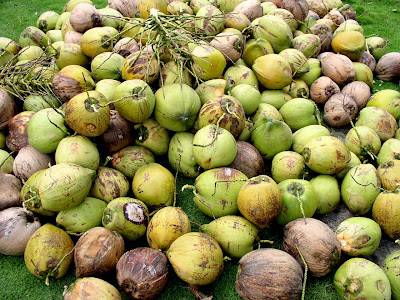 This is the usual three-monthly coconut harvest from the sixteen trees in my garden. The usual haul is 5 sacks, each of about 25 kilos kopras meat (about 100 pieces per sack).
This is the usual three-monthly coconut harvest from the sixteen trees in my garden. The usual haul is 5 sacks, each of about 25 kilos kopras meat (about 100 pieces per sack).It's a wonderful, bountiful tree - see: Coco Loco
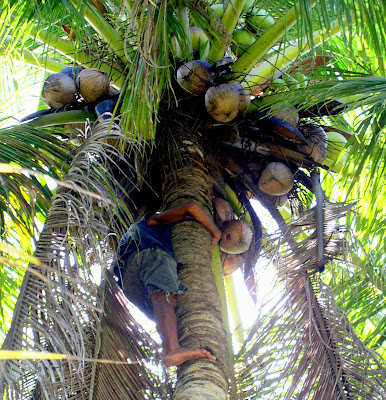 It does everything you can think of, except, possibly, marriage guidance, but it's almost certainly got a secret chemical that will help with that kind of problem.
It does everything you can think of, except, possibly, marriage guidance, but it's almost certainly got a secret chemical that will help with that kind of problem.One brave fellow climbs the trees and trims off the ripe coconuts, and they come crashing down like small bombs.
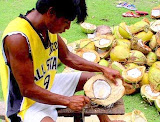
Then they chop the whole nuts in half, and scoop out the meat with a specially-shaped knife, a lugit.

The meat is now kopras, but it has to be dried first, in a tapahan, which is really a bodged-up smokehouse, like this. The smouldering coconut husks are used for fuel, and the process takes most of a day.
I've often wondered why the operators of the tapahan don't also use the process to cold smoke a few fish or sides of pork, but perhaps they've never thought of it
Monday, 18 August 2008
Fidelity - Female Fruit Flies Only Fuck on the First Date
 I'm not a lot interested in fruit flies, as such, but they (Drosophila) have been a great deal helpful to science in general and especially in the genetics corner.
I'm not a lot interested in fruit flies, as such, but they (Drosophila) have been a great deal helpful to science in general and especially in the genetics corner.It seems that female fruit flies are fussy. After the first time they have intercourse, they don't want to do it again.
Someone has discovered (or thinks he has) how.
Now this is how you find out the the details of the complicated and devious mind of the female fruit fly.
You feed them. With yeast that contains lots of heavy nitrogen. That isotope labels all of the female proteins.
Then you look at them after they've fucked. Anything that didn't have the heavy nitrogen was given by males. The researchers discovered some sixty-three proteins from fruit fly semen, which may suggest that the male fruit fly lacks confidence in his wife's fidelity, and is over-doing it a bit.
(Sorry to anyone who's offended by the fffour-letter word - the alliteration was just too good to resist).
Sunday, 17 August 2008
Curacha Dancing Crabs
 Curacha dancing crabs are a speciality of Zamboanga, at the extreme right hand bottom of the Philippines.
Curacha dancing crabs are a speciality of Zamboanga, at the extreme right hand bottom of the Philippines.The first time I ate them, there, I found myself sitting at the next table to Nur Misuari, the politician then in charge of the Muslim provinces (ARMM) of Mindanao, and they were delicious (no, not the politician and his cronies, but the crabs).
Since then, of course, Muslims have gone very much out of fashion.
Nur Misuari's done a bit of jail time since, but then so should anyone who sets out to be a politician; a little bit of waterboarding wouldn't go amiss.
But we also have curachas here, in Siargao, where they are known as kanduyon or ladan.
They are good to eat, because almost all the useful stuff is in the main shell, so you don't need to fuss about too much.
They're called dancing crabs, because they sit upright in the water, on their back legs, and ponce about, like a bunch of poofs at a party.
Notice their claws; they're not a lot of use, being angled in the wrong way, quite against heavy usage. they merely use them for posing.
If these things were created, then the Great Creator made more than a few design mistakes. Thank God, He won't be held accountable.
But Thank God, He made them tasty. You can find some better photos than mine here.
Saturday, 16 August 2008
Siargao Zingiber Project - Sidelining
We went to Victor's Flying Fox Bar, built, like only a total crazy could do, out in the boonies, opposite a perfect jungle mountain, where the flying foxes do a grand fly-past every evening, dead on time at 2.5 minutes past dusk.
We walked along the edge of the mountain, and we did find a couple of new ginger plants (which I'm waiting to have identified).
But, more than that, we found some other strange plants that I don't have much of a clue about:
+P1010005-1.JPG)
This is wild ubi, a purple yam, that, domesticated, is a great favourite here in the Philippines. It's even a top flavour for ice cream. Purple ice cream? It's delicious. Only in the Philippines.
 And we found these, abandoned: Puso banana buds, but only the stripped skins, the buds taken off to make into a fabulous salad.
And we found these, abandoned: Puso banana buds, but only the stripped skins, the buds taken off to make into a fabulous salad.And then this one, known locally as padjaw. It's an aroid, but I don't know much more about it, and I don't know why it grows 'pretend peppers'.
Siargao Zingiber Project - 1
It seems, according to John Mood, a 20-year expert on ginger (Zingiber) plant taxonomy, that we may just have a new species on our hands.
Here, it's called kayaskason, and it's very common. John asked me to preserve the leaves and inflorescence (a la herbarium, pressed between newspaper sheets). This is a bit difficult, because we don't get newspapers hereabouts, and the big fruits don't really press very well.
However, I'll do my best.
I proposed, very strongly, based on the first specimens that Ron brought to me, that the damned plant didn't have flowers.
But it does.
 Here's a picture of one, a bud popped into a vase of water at 5pm and open and greedy at 7pm.
Here's a picture of one, a bud popped into a vase of water at 5pm and open and greedy at 7pm.I'm not a botanist, so I really didn't know that my photo was upside down.
It looked extraordinarily like the face of one of the
 local horseshoe bats. Even down to the two very small 'eyes' either side of its 'nose'.
local horseshoe bats. Even down to the two very small 'eyes' either side of its 'nose'.Now, if I was a bat, I'd visit this flower, and land on the strong stem just behind it. Then I'd bend over, and find I was facing the thing upside down. I would be doing 69 face to face with a friend from another biological kingdom.
Probably, I'd lap up all the ants crawling around the nectar, and then lap up some of the delectable stuff for myself.
Friday, 15 August 2008
Morning Bakery
 Every morning at 5am, as the sun rises, reluctantly, Bebot's wife makes bread rolls, and they're wonderful.
Every morning at 5am, as the sun rises, reluctantly, Bebot's wife makes bread rolls, and they're wonderful.They're not the usual Philippines pan-de-sal, that are altogether too sweet and mushy. These are almost genuine, unsugared, bread rolls.
I buy them for breakfast (for dunking in coffee or Milo) or even, sometimes, as a special 'English' treat (sliced hot with plenty of butter and a bit of Marmite).
The oven is very high-tech. It's a galvanised iron box, with a folded corrugated-iron roof folding over. This one even has a heat shield at the front. It's fired by a pile of smouldering coconut husks on top. Bebot's wife manipulates the bread rolls with something like a bugsay (paddle), with which she whips them around like a flock of sheep.
But the main problem is that no-one in the Philippines has ever learned to make bread properly. They use soft flour; they don't mature their yeast, etc. There is nothing here remotely resembling the fresh early morning French baguette; they learned bread-making from the Spanish, who haven't a clue.
And that's a big disappointment; I would love to eat a fresh hot baguette every morning. Maybe I'll get out there one morning and start preaching. I love fresh morning-cooked bread.
Thursday, 14 August 2008
Rabuls - Fighting Spider
 The kids here find these spiders around the place. Then they set pairs of spiders to fight along a piece of silhig (that piece of the centre of a coconut leaf, that are normally used to make brooms here).
The kids here find these spiders around the place. Then they set pairs of spiders to fight along a piece of silhig (that piece of the centre of a coconut leaf, that are normally used to make brooms here).This is a huge thing amongst the local children (who haven't got many shop-bought toys, so they have to use their imagination in ways that spoiled Western brats could never do).
They keep their champions jealously, in empty match boxes, and even trade them amongst their friends. One good spider can be worth seven pieces of candy.
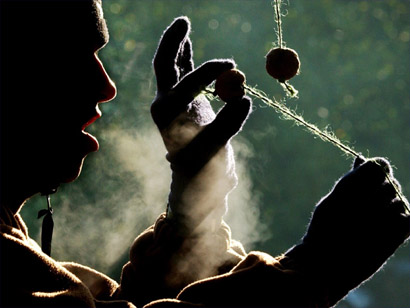 Then I think back to my own youth; we used to have conkers (horse-chestnuts) that we collected in the local woods. You strung the conker and slung it against your opponent's. If that broke, you won.
Then I think back to my own youth; we used to have conkers (horse-chestnuts) that we collected in the local woods. You strung the conker and slung it against your opponent's. If that broke, you won.
Wednesday, 13 August 2008
Coconut Bubble
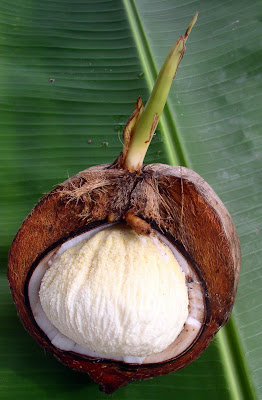 This is a coconut in the process of sprouting. It's sent out a small shoot through one of the three 'eyes' at the top of the coconut shell, and soon it will send out some roots through another one.
This is a coconut in the process of sprouting. It's sent out a small shoot through one of the three 'eyes' at the top of the coconut shell, and soon it will send out some roots through another one.The roots will go down, while the shoot stays up, so the shell will remain on the ground but keel over, as the roots take hold.
The bubble, buwa, is the conversion of the water and flesh inside the coconut shell into an embryo of the future coconut tree. Amazing how alike this process is to mammal reproduction, where the womb holds and feeds the embryo.
This one is well on the way, so the bubble has almost filled the hard shell, while the roots haven't got going just yet. Much of the coconut flesh is still there. Give it time.
 Now, if you can catch a coconut that hasn't quite reached this stage (where the bubble gets a little bit spongy) then you get this, and it's delicious.
Now, if you can catch a coconut that hasn't quite reached this stage (where the bubble gets a little bit spongy) then you get this, and it's delicious.It tastes like a sort of coconut marshmallow, juicy, fresh and sweet.
Tuesday, 12 August 2008
Rejected Artists & Transparent Trousers
 Ever since I first visited Paris, at the age of sixteen, I've had the ambition to be a Rejected Artist. I wanted to live in a garret in Paris or Soho, paint works of genius like Vincent Van Gogh, then come back from Heaven to see what nice things people said about my stuff long after I'd gone.
Ever since I first visited Paris, at the age of sixteen, I've had the ambition to be a Rejected Artist. I wanted to live in a garret in Paris or Soho, paint works of genius like Vincent Van Gogh, then come back from Heaven to see what nice things people said about my stuff long after I'd gone.Well, here's a rejected artist; Percy Wyndham-Lewis, standing outside the Royal Academy in London, in 1938.
Note:
- the cigar
- the well-made suit (but the awful faux-pas of leaving all three buttons done up)
- the silk scarf
- the patent leather shoes
- and worst of all, the spats on those shoes
And here's the reason for his rejection (only from the RA Summer Exhibition) - his portrait of T S Eliot, one of the most boring and inconsequential poets of all time.
 The painting is good:
The painting is good:- the top half plagiarises a few clues from Gauguin (or some Vorticists)
- the middle part is a good portrait, in spite of a useless lot of effort to be Cubist.
But the bottom part? Well, it takes a lot of artistry to paint a famous poet with transparent trousers.
Is this an iconographic signal? Were Wyndham-Lewis and Eliot a little bit more than male friends?
Yes.
Now here is what Wyndham-Lewis was trying to emulate: something like this Juan Gris cubist portrait of Pablo Picasso, painted 30 years before.

Take a very close look at this. Cubism was supposed to be a new way of looking at things; putting three dimensions, and the different facets of them, into two.

And here's why; my own 'cubist' portrait of Percy Wyndham-Lewis (complete with arrogant cigar) executed in about 10 minutes, using the Paint.Net program.
You won't recognise Wyndham-Lewis, but then you won't recognise the young Pablo Picasso in John Grey's portrait, either.
That's not the point. This is Art.
Sunday, 10 August 2008
Venus in Blue Jeans
 I've been having a lot of idle fun in the past few days, playing with the Paint.Net program. It's fun, it's free, and (I think) it does most of what you might want.
I've been having a lot of idle fun in the past few days, playing with the Paint.Net program. It's fun, it's free, and (I think) it does most of what you might want.This is John Everett Millais' 'Venus Verticordia' (Venus will turn your heart vertical). It's a winsome, bee-stung lipped nonsense, with slight symptoms of thyroid trouble in her neck.
 Here, on the other hand, by Hans Memling, is an old lady who's seen it all.
Here, on the other hand, by Hans Memling, is an old lady who's seen it all.She ain't going to take shit from nobody.
 But this is the best, the Rokeby Venus, by Diego Velázquez.
But this is the best, the Rokeby Venus, by Diego Velázquez.Truly, Venus in Blue Jeans, and one of the best bums ever painted.
Pano'on - Local Candy - Bromeliad or What? - Part II

Brandon also introduced me to John Mood, a world authority on ginger taxonomy, who confirmed the plant was probably Hornstedtia conoidea, which also grows in Borneo.
Well, I hadn't seen much more of the plant than a few ripening buds and a few leaves, which had made me think it was this: Zingiber mioga - Japanese Wild Ginger, which is commercially-grown in Japan (and now in New Zealand) for its young buds, which are a great delicacy.

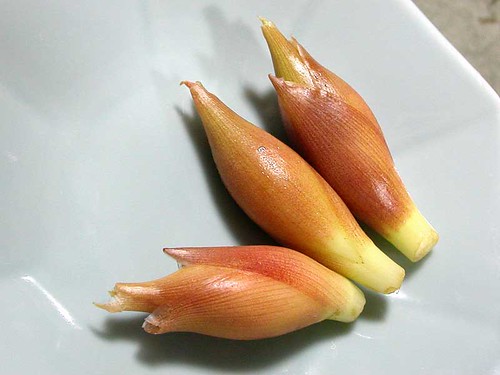 The buds are shown here:
The buds are shown here:(Click photo to go to 'the scent of green bananas blog for recipes)
Well, this really got me thinking. If New Zealand farmers are canny enough to grow this stuff for export to Japan, why shouldn't we do the same here in Siargao? Looked easy to me; it's a perennial, so you plonk it in the ground, and pick a bit idly from time to time.
But if you look at the botanical drawing, you'll see that mioga has a white flower, whereas our pano'on's flowers turn out to have a brilliant deep red flower (top right). And the local people don't eat the buds, although they do eat the unripe berry pods (and so do rats and other forest rodents - we didn't find a single young bud on the specimens Ron brought back, from his second expedition on Thursday).
Ron also mentioned another ginger relative, locally known as kayaskason, which also has edible berries, growing at the top of a long stem, so I asked him to get some of those as well, plus anything else he could find. He came up trumps. Kayaskason turns out to be a species of Alpinia, or even a natural hybrid, and extremely rare. It seems strange that it is common enough here for the local people to give it a name.
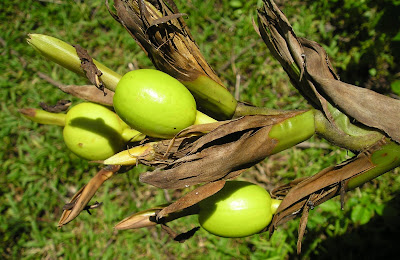
Well, that's exciting enough, but this photo shows only the unripe seed pods. We've planted it in the garden, but I don't think I can wait for the flowers to come out, so I guess we'll have to go and get some, to finally find out what it is.
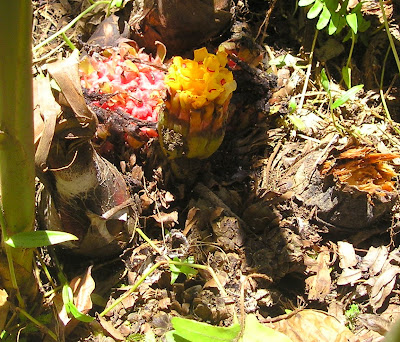 But the third wild ginger that Ron brought back turns out to be a little honey. You can see in this photo the yellow flowers and pink fruit. Here's another photo of the pink fruit.
But the third wild ginger that Ron brought back turns out to be a little honey. You can see in this photo the yellow flowers and pink fruit. Here's another photo of the pink fruit.
This one, apparently, is an Etlingera fimbriobracteata.
Now that I know these marvels are to be found in the forests around here, I'll be looking out for them.
Saturday, 9 August 2008
Pool Swimmer
Look at the photo above - 'nuff said.
Friday, 8 August 2008
Marang Fruit
 Marang - Artocarpus odoratissimus
Marang - Artocarpus odoratissimusThis fruit is about halfway between jackfruit and breadfruit, and a member of the same family. It grows on large trees (larger usually than jackfruit) and smells wonderful. That, of course is why someone called it 'odoratissimus'.
The skin is made of countless tiny tubules or spines, and you simply cut through it and twist it off, to reveal the individual fruit (actually arils, about the size of a grape). Each one of these has a large seed inside (which you can also eat, after boiling or roasting).
 There's not a lot of taste to a marang, but it does smell good.
There's not a lot of taste to a marang, but it does smell good.These are some I photographed in the Surigao City fruit market, going nicely yellow as they ripen.
Actually, there's a superb photograph at MVI~'s photostream at Flickr, which I can't compete with.
You'll also find more information at the ever-indispensable Wikipedia.
Shedney loves them; I am ordered, indeed commanded, to bring some whenever I do a bank run to Surigao City.
(There don't seem to be many exotic local fruit available here on Siargao Island. If people have a tree like this in their garden, it tends to go to the family, and no-one else).
Thursday, 7 August 2008
Santol Fruit
 I can't do better than to quote The Daley News, an Australian tree nursery, on this fruit:
I can't do better than to quote The Daley News, an Australian tree nursery, on this fruit:Fruit Tree of the Month
Santol - Sandoricum koetjape
Native to Asia the Santol is a large fast growing and attractive tree. In their native setting they can grow to around 45 m with a large buttressed trunk and branches low to the ground.
In cultivation they are more commonly seen as a 15 m specimen tree. In Asia the santol is valued not only for its fruits but it is also grown as a timber and shade tree, although the timber is not of high quality it does polish well.
The fruits are large, round and rough on the outside with a thick textured yellowish skin. The flesh is segmented around the 3-5 seeds, they are called lolly fruits as the flesh sticks firmly to the seeds and it is best removed and enjoyed by sucking the seeds clean. Do not be tempted to swallow the seeds.
I find these fruit (or at least the 'lolly' part) to be as insipid as so many other South East Asian fruit, a sort of jellified sweet flesh with a flavour so goddam subtle that I have difficulty describing it. And the flesh sticks to the seeds like slimy cotton wool. However,the orange skin is marvellous; very tart, and solid.
I've used it to make some very, very acceptable chutney, the kind that nearly substitutes for Branston Pickle, the essential ingredient for a genuine cheese-and-pickle sandwich.
Wednesday, 6 August 2008
Nukos Tinola
 This delicious Filipino soup is the kind of thing that Shedney used to make for me when she was trying to impress me.
This delicious Filipino soup is the kind of thing that Shedney used to make for me when she was trying to impress me.I won't bother to give an ingredients list, because it doesn't matter very much. This is a dish made at the moment from whatever you have available.
Take the usual onions, garlic, ginger, and so on, plus any spices you particularly like, give them a quick fry, and then throw in some fresh squid (nukos) , and whatever bits of vegetables you have around (this lot included mange-tout (snowpeas - a recently introduced vegetable, but nice, all the same), local cucumber, tomatoes, and some unidentifiable green leaves, probably kangkong (swamp lettuce) - the oval white things are cucumber seeds from the local cucumber; sikwa).
Don't cook it too much. You want the squid tasty and tender, not like bits of boiled rubber.
Then add water. Easy, isn't it? And delicious.
Tuesday, 5 August 2008
Gecko Corner
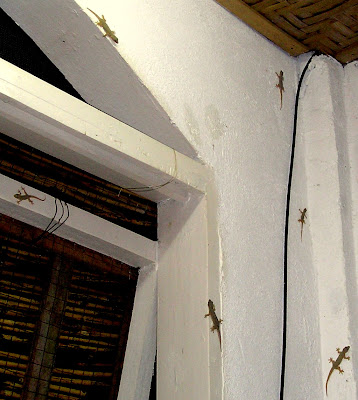 This is Gecko Corner, just above the righthand side of my Siargao Island 'home office' at about 7 pm. All of the extended family are out there, and they're patrolling the best bits for tasty insect nibbles.
This is Gecko Corner, just above the righthand side of my Siargao Island 'home office' at about 7 pm. All of the extended family are out there, and they're patrolling the best bits for tasty insect nibbles.Actually, there are half a dozen more, to the left side, but they all maintain very careful territories. Sometimes, there's a little bit of a flurry, with a gecko growl and a scuffle; they are quarrelling about sex or territory rights, both of which seem to be prevalent problems amongst most animal groups.
Geckos have evolved amazing abilities for holding onto vertical and even sub-horizontal surfaces. They can stick to anything...sometimes. See: Gecko's amazing sticky feet
 and when that doesn't work, they can turn around, mid-air, to make sure they land properly:
and when that doesn't work, they can turn around, mid-air, to make sure they land properly:See:
Tail 'key' for gecko acrobatics
They are all around my house; and are fairly ambitious.

Sometimes they fall off the ceiling.
When they land, stunned for a moment, you can see the thought, in their eyes 'Where the f*** am I now?'
This one plopped onto my computer keyboard.
Other stuff drops into my evening drink occasionally.
Some mornings I find some poor soused gecko in the glass I left on the table.
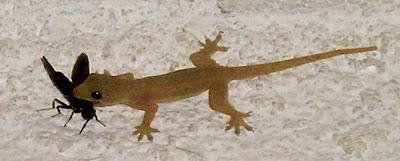
This little fellow is trying to eat a moth more than half his body size (excluding head and tail).
He can't bite the insect in half; he'll just have to do the best he can to swallow it whole.

Very occasionally, the geckos stop fighting each other, and have some fun.
I'm going to be very careful about this, because Google might put me on the pornography blacklist if I publish this photo.
But look at their eyes; neither look exactly ecstatic; much like humans, really.
My apologies for the f***ed up layout of this post (and others). Google's Blogger has been giving me much angst today.
Monday, 4 August 2008
Lato Seaweed Salad
Koi-Koi, my neighbour, brings me some from time to time, often together with some tajum, sea urchin roe, and they go well together.
They taste like salty little grapes, bursting in the mouth in the same way as caviare, but they're a
 lot cheaper.
lot cheaper.This kind is my favourite. The branches are like little green Walt Disney toadstools.
To eat them, all you do is collect them straight from the sea. If you haven't got fresh sea water to rinse them in, use a little vinegar. But make sure you do wash them; a lot of tiny crabs and shrimp live in the bunches, and you don't want to chomp those as well.
I also featured another kind of lato at: Seaweeds as Food
+P1010019.JPG)
